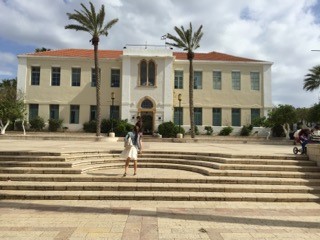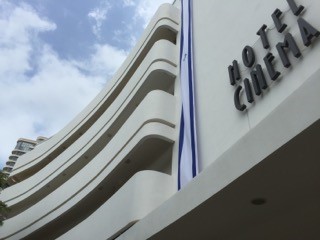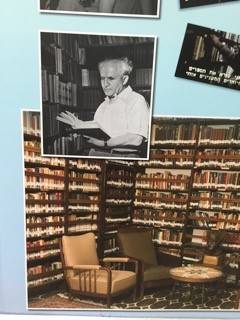
By Steve Kramer

TEL AVIV — In the first part of this series, we toured Jerusalem with my brother Charles, who was visiting from America. Next, we traveled with him to Tel Aviv. What was very special about Charles’ trip was the timing. As we entered Tel Aviv in the early afternoon, we were very aware of the fact that in a few hours a country-wide siren would sound and the country would literally come to a standstill for the beginning of the Memorial Day for Soldiers and Victims of Terror. Still, we had time to visit the Museum of the Jewish People (Beit Hatfutsot) on the University of Tel Aviv campus. First, there was a special showing on Amy Winehouse and her short life. Then my wife Michal and I saw a special exhibition on Jewish tailors and designers (Ralph Lauren, Donna Karan, etc.) while Charles visited a few of the regular museum galleries.
On Israel’s Memorial Day (which starts at 8.00 pm on the previous evening), all entertainment establishments are closed. There are no special sales, nor is it a day for picnics, just a work day with a heavy dose of remembrance and grief. We had arranged to have dinner at the Rothschild Hotel, which is the sister hotel to where we stayed, the Diaghilev Art Hotel, a few blocks away. Soon after we finished a delicious dinner, the 1-minute siren sounded.
We made our way to Rabin Square, a large plaza named in commemoration of Yitzhak Rabin, who was assassinated on that very spot in 1995. There were thousands of people thronging the square, watching and listening to speeches emanating from Mt Herzl Military Cemetery in Jerusalem. After the conclusion of the ceremony, nostalgic songs were sung and people reflected on those who had paid the awful price for our Jewish country.
In the morning, we left our well-located apartment-style hotel to visit the Yitzhak Rabin Center, which includes both a history of Rabin and a contemporaneous history of the State of Israel. Just before we entered the museum, we stood at attention for Memorial Day’s second siren. The museum pays attention to detail and presents the history of Israel in a unique way. As usual, there was not enough time to view all the exhibits.
Returning to the center of town at Dizengoff Circle, we met our guide for the afternoon, Yigal Gawze, an architecturally trained photographer, who guided us through the “White City,” a UNESCO World Heritage site. The name White City has been given to Tel Aviv because of the abundance of white, International Style buildings which grace the city. Our friend Steve, who runs the excellent israelseen.com blog, joined us.
Yigal explained that the concept for a new garden city, to be called Tel Aviv, was developed on the sand dunes outside Jaffa in 1909.
According to Wikipedia, “The Scottish urban planner Patrick Geddes, who had previously worked on town-planning in New Delhi, was commissioned by Tel Aviv’s first mayor, Meir Dizengoff, to draw up a master plan for the new city. Geddes began work in 1925 on the plan, which was accepted in 1929.”
Yigal also told us how “Bauhaus” architecture (the local name given to the International Style) became so prevalent in the city and throughout Israel. This spare, modern style of design and building, epitomized by Le Corbusier and Mies Van de Rohe, developed mainly in Germany, Holland and France, during the 1920s, before it migrated to America. Perhaps its most influential center was the Bauhaus School at Dessau in Germany, which closed in 1933, in the early years of the Nazi era. Because many European architects and Palestinians (Jews living in pre-state Israel) studied there and either immigrated, or returned to Israel, “Bauhaus” became the name adopted by Israelis for this new style. This building boom of thousands of International Style buildings coincided with the need for increased building based on the Geddes plan.
 Typical characteristics of International Style buildings include geometric forms devoid of ornamentation, open interior spaces, and the use of modern materials such as glass, steel and concrete. As we walked through the Dizengoff Circle neighborhood, Yigal pointed out the best examples of the Bauhaus style, including the uniform Bauhaus buildings around the circumference of the circle. We learned how architects in the Yishuv (pre-state Israel) modified some of the features of the International Style to suit the conditions of a hot, Mediterranean climate. I.e.: the balconies included an open slit near the bottom of the exterior wall to enable air circulation, windows were made smaller to keep out the heat, and the buildings were often raised on pillars to allow for shaded areas underneath.
Typical characteristics of International Style buildings include geometric forms devoid of ornamentation, open interior spaces, and the use of modern materials such as glass, steel and concrete. As we walked through the Dizengoff Circle neighborhood, Yigal pointed out the best examples of the Bauhaus style, including the uniform Bauhaus buildings around the circumference of the circle. We learned how architects in the Yishuv (pre-state Israel) modified some of the features of the International Style to suit the conditions of a hot, Mediterranean climate. I.e.: the balconies included an open slit near the bottom of the exterior wall to enable air circulation, windows were made smaller to keep out the heat, and the buildings were often raised on pillars to allow for shaded areas underneath.
We saw numerous examples of beautifully restored Bauhaus buildings but just as many examples of buildings woefully in need of restoration. We also saw cooperative workers’ apartment blocks, whose aim was to provide residents with equality of living quarters, usually surrounding a courtyard with amenities. The latter part of the tour was in the Rothschild Boulevard neighborhood near our hotel. We were surprised to discover very bucolic neighborhoods just yards away from the busy thoroughfare. Yigal’s tour was a real treat and is highly recommended. (http://telavivbauhauswalk.com)
After enjoying coffee on the boulevard, we relaxed before returning to the hotel. As the evening approached, the somber mood of the day began to morph into a celebration of Israel’s Declaration of Independence on May 14, 1948. This mixture of grief and memorializing turning into joy at the emergence of the State of Israel is uniquely Israeli, combining the bitter and the sweet, symbolizing the reality that our independence is intrinsically linked with our sacrifice to achieve – and ability to maintain – our freedom.
That evening, to celebrate Yom Ha’atzmaut (Independence Day), we drove to Netanya to attend the annual dinner dance of the Forgotten People Fund (FPF). This grass roots charity, for which Michal and I volunteer, exists to help the Ethiopian Israelis of Netanya to enter the mainstream of life in Israel. Starting years ago by giving out food coupons, FPF now concentrates on providing scholarships for professional studies, as well as subsidies for summer camp and urgent assistance for families referred to us by the city’s social workers, with problems such as broken appliances and cut-off of utilities. This year’s event contributed about $10,000 to FPF coffers, a considerable sum which will be totally distributed via FPF programs. (www.fpf.org.il)

Thursday, Independence Day, was Charles’ last in Israel. We spent the day with friends, exploring Tel Aviv. We first went to the David Ben-Gurion House, in which Israel’s first prime minister lived for most of his adult life before retirement. Located near the sea, the relatively large house (which may have been two apartments originally) was very simple, which was the style of Israel’s first leaders. It was dominated by Ben-Gurion’s huge library, which encompasses almost the entire second floor. There were many other visitors, including loads of children who had a special room set up for arts and crafts projects on the theme of independence and Prime Minister Ben-Gurion.
We then went down to the beach to see the flyover by the Israel Air Force, which was fun and included some awesome displays. The show was somewhat hampered by the unusual, fierce wind which buffeted the spectators. Nonetheless, thousands along the beachfront stayed to the end.
We then drove to the other side of town to the Yemenite Quarter, also near the sea and adjacent to the Carmel Market, Tel Aviv’s shuk (outdoor market). For the rest of the afternoon, the weather alternated between warm sun and light rain. That didn’t stop many from picnicking in the parks or eating in the restaurants. We found two adjacent Yemenite eateries serving simple, delicious-looking food. We took the first table offered to us and had a great lunch. Afterwards, we wandered into the adjacent Neve Tzedek neighborhood. While both areas date back to Tel Aviv’s founding early in the 20th century, Neve Tzedek is in the process of massive gentrification, with many cultural centers, restaurants, designer shops, and beautiful, reconstructed houses. Particularly impressive is the Suzanne Dellal Center for Dance and Theater, where the Bat Sheva and Inbal dance troupes are based.
We finished our day, of course, with coffee and great ice cream down an alley from Suzanne Dellal. We all had a fabulous time during this busy week, made all the more meaningful for Charles by the inclusion of Memorial Day and Independence Day. We hope more tourists will come to Israel soon to see the miracle that has been accomplished in just 67 years!
*
Kramer is a freelance writer based in Alfe Menashe, Israel.
__________________________________________________________________
Care to comment? We require the following information on any letter for publication: 1) Your full name 2) Your city and state (or country) of residence. Letters lacking such information will be automatically deleted. San Diego Jewish World is intended as a forum for the entire Jewish community, whatever your political leanings. Letters may be posted below provided they are responsive to the article that prompted them, and civil in their tone. Ad hominem attacks against any religion, country, gender, race, sexual orientation, or physical disability will not be considered for publication. There is a limit of one letter per writer on any given day.
__________________________________________________________________